Abstract
OBJECTIVE--The aim was to assess the determinants of benzo(a)pyrenediol epoxide adducts to haemoglobin (BaPDE-Hb) in workers exposed to polycyclic aromatic hydrocarbons (PAHs). METHODS--This was a study of the correlations between the concentrations of PAHs in air, 1-hydroxyprene in urine, and BaPDE-Hb adduct concentration in the blood in 206 men working in steel foundries and one graphite electrode producing plant, taking into consideration confounding factors such as smoking and dietary habits. RESULTS--BaPDE-Hb adduct concentration was correlated (r = 0.26; p = 0.0002) with the airborne PAH concentration and was influenced by tobacco consumption but not by dietary habits. Benzo(a)-pyrene concentration in air, 1-hydroxypyrene concentration in urine, and duration of exposure to PAHs were not associated with the adduct concentration. CONCLUSION--Although environmental exposure to PAHs was statistically associated with BaPDE-Hb adduct concentration, differences between individual subjects in the metabolism of benzo(a)pyrene probably play an important part in determining the amount of BaPDE-Hb adducts formed.
Full text
PDF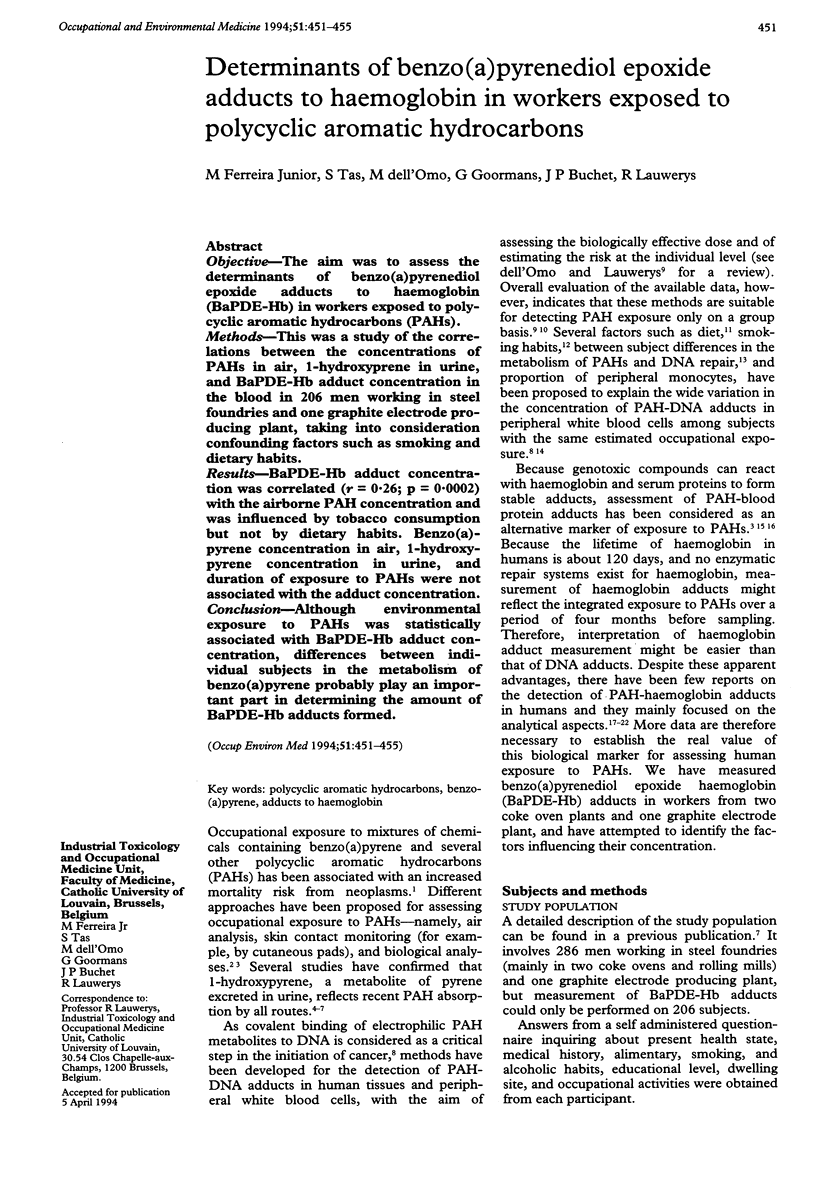
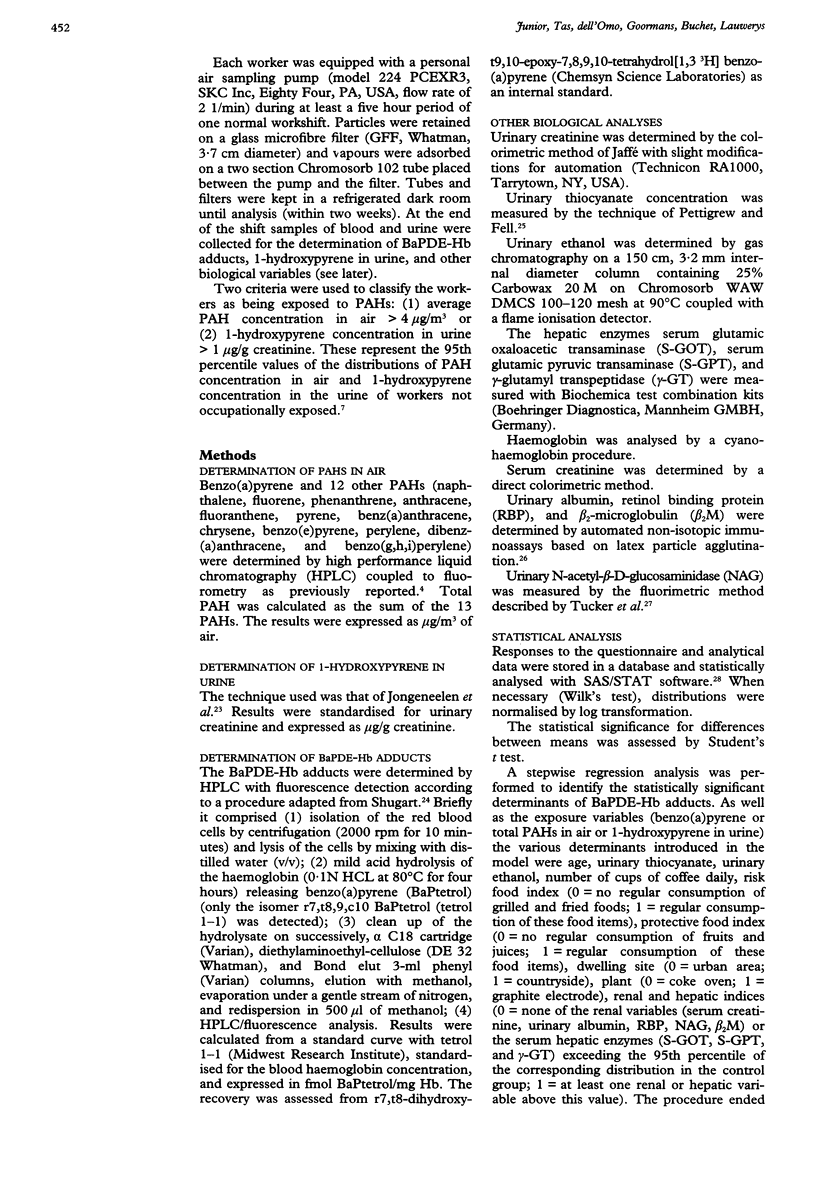
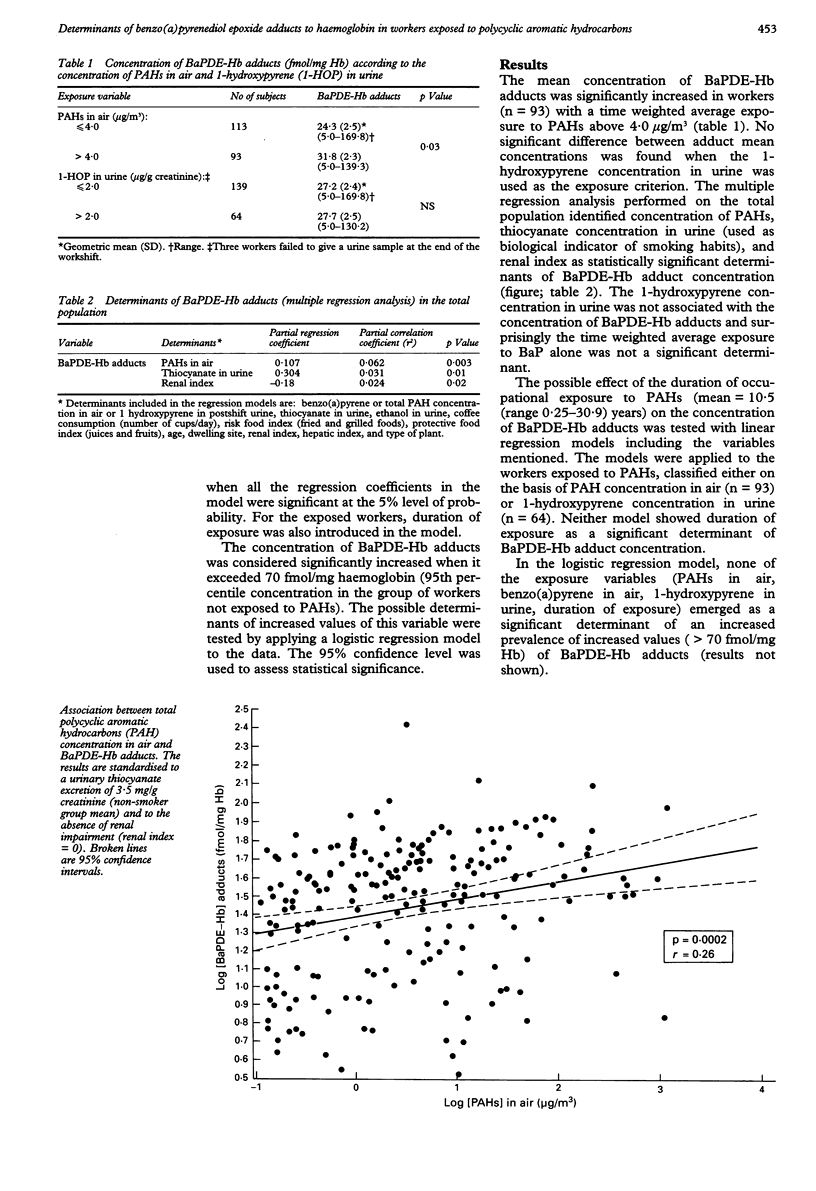
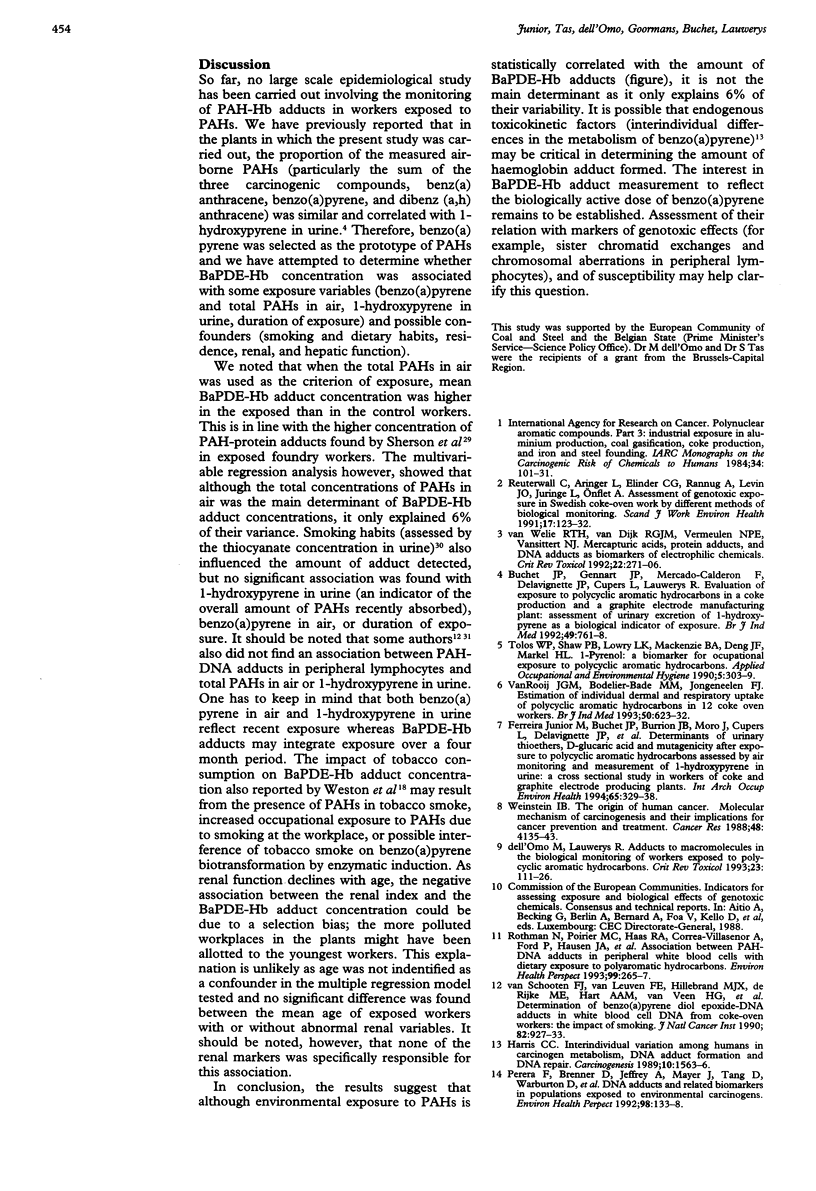
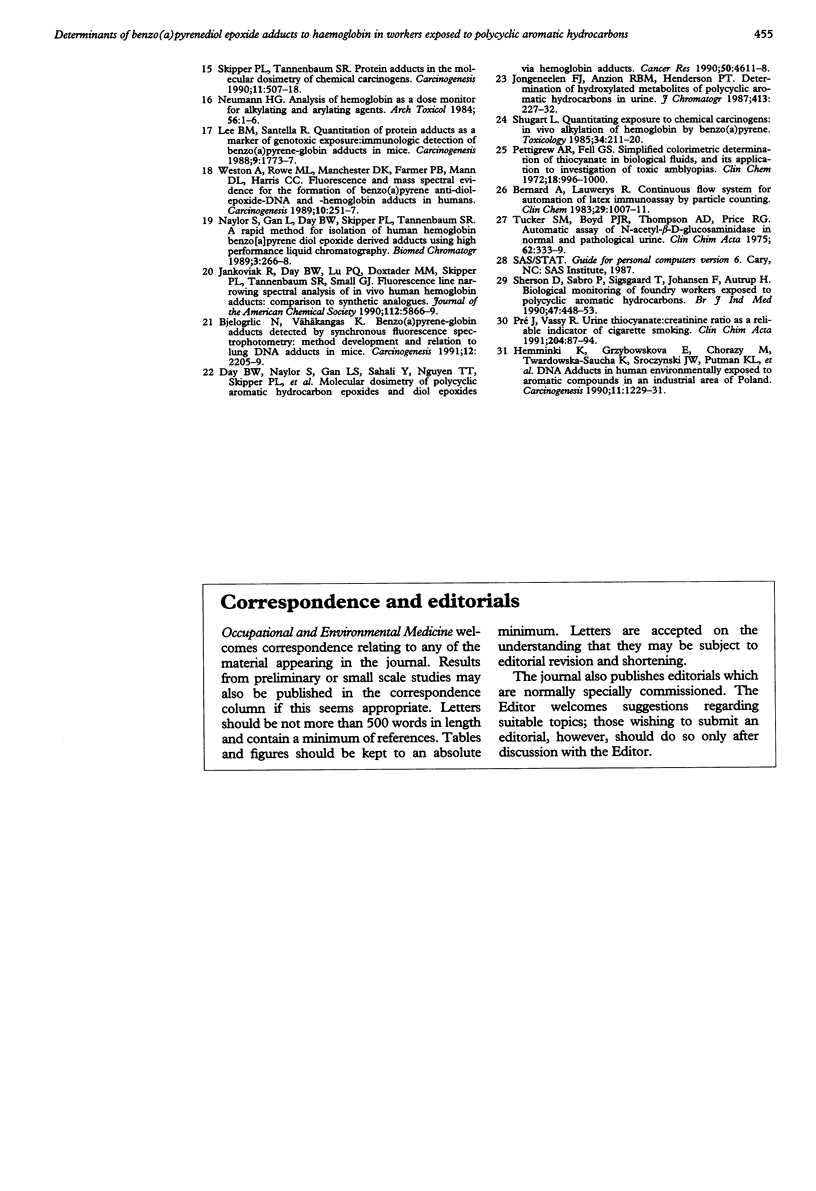
Selected References
These references are in PubMed. This may not be the complete list of references from this article.
- Bernard A. M., Lauwerys R. R. Continuous-flow system for automation of latex immunoassay by particle counting. Clin Chem. 1983 Jun;29(6):1007–1011. [PubMed] [Google Scholar]
- Bjelogrlic N., Vähäkangas K. Benzo[a]pyrene-globin adducts detected by synchronous fluorescence spectrophotometry: method development and relation to lung DNA adducts in mice. Carcinogenesis. 1991 Dec;12(12):2205–2209. doi: 10.1093/carcin/12.12.2205. [DOI] [PubMed] [Google Scholar]
- Buchet J. P., Gennart J. P., Mercado-Calderon F., Delavignette J. P., Cupers L., Lauwerys R. Evaluation of exposure to polycyclic aromatic hydrocarbons in a coke production and a graphite electrode manufacturing plant: assessment of urinary excretion of 1-hydroxypyrene as a biological indicator of exposure. Br J Ind Med. 1992 Nov;49(11):761–768. doi: 10.1136/oem.49.11.761. [DOI] [PMC free article] [PubMed] [Google Scholar]
- Day B. W., Naylor S., Gan L. S., Sahali Y., Nguyen T. T., Skipper P. L., Wishnok J. S., Tannenbaum S. R. Molecular dosimetry of polycyclic aromatic hydrocarbon epoxides and diol epoxides via hemoglobin adducts. Cancer Res. 1990 Aug 1;50(15):4611–4618. [PubMed] [Google Scholar]
- Ferreira M., Jr, Buchet J. P., Burrion J. B., Moro J., Cupers L., Delavignette J. P., Jacques J., Lauwerys R. Determinants of urinary thioethers, D-glucaric acid and mutagenicity after exposure to polycyclic aromatic hydrocarbons assessed by air monitoring and measurement of 1-hydroxypyrene in urine: a cross-sectional study in workers of coke and graphite-electrode-producing plants. Int Arch Occup Environ Health. 1994;65(5):329–338. doi: 10.1007/BF00405698. [DOI] [PubMed] [Google Scholar]
- Harris C. C. Interindividual variation among humans in carcinogen metabolism, DNA adduct formation and DNA repair. Carcinogenesis. 1989 Sep;10(9):1563–1566. doi: 10.1093/carcin/10.9.1563. [DOI] [PubMed] [Google Scholar]
- Hemminki K., Grzybowska E., Chorazy M., Twardowska-Saucha K., Sroczynski J. W., Putman K. L., Randerath K., Phillips D. H., Hewer A., Santella R. M. DNA adducts in human environmentally exposed to aromatic compounds in an industrial area of Poland. Carcinogenesis. 1990 Jul;11(7):1229–1231. doi: 10.1093/carcin/11.7.1229. [DOI] [PubMed] [Google Scholar]
- Jongeneelen F. J., Anzion R. B., Henderson P. T. Determination of hydroxylated metabolites of polycyclic aromatic hydrocarbons in urine. J Chromatogr. 1987 Jan 23;413:227–232. doi: 10.1016/0378-4347(87)80230-x. [DOI] [PubMed] [Google Scholar]
- Lee B. M., Santella R. M. Quantitation of protein adducts as a marker of genotoxic exposure: immunologic detection of benzo[a]pyrene--globin adducts in mice. Carcinogenesis. 1988 Oct;9(10):1773–1777. doi: 10.1093/carcin/9.10.1773. [DOI] [PubMed] [Google Scholar]
- Naylor S., Gan L. S., Day B. W., Skipper P. L., Tannenbaum S. R. A rapid method for isolation of human hemoglobin benzo[a]pyrene diol epoxide derived adducts using high performance liquid chromatography. Biomed Chromatogr. 1989 Nov;3(6):266–268. doi: 10.1002/bmc.1130030608. [DOI] [PubMed] [Google Scholar]
- Neumann H. G. Analysis of hemoglobin as a dose monitor for alkylating and arylating agents. Arch Toxicol. 1984 Nov;56(1):1–6. doi: 10.1007/BF00316343. [DOI] [PubMed] [Google Scholar]
- Perera F., Brenner D., Jeffrey A., Mayer J., Tang D., Warburton D., Young T. I., Wazneh L., Latriano L., Motykiewicz G. DNA adducts and related biomarkers in populations exposed to environmental carcinogens. Environ Health Perspect. 1992 Nov;98:133–137. doi: 10.1289/ehp.9298133. [DOI] [PMC free article] [PubMed] [Google Scholar]
- Pettigrew A. R., Fell G. S. Simplified colorimetric determination of thiocyanate in biological fluids, and its application to investigation of the toxic amblyopias. Clin Chem. 1972 Sep;18(9):996–1000. [PubMed] [Google Scholar]
- Pré J., Vassy R. Urine thiocyanate:creatinine ratio as a reliable indicator of cigarette smoking. Clin Chim Acta. 1991 Dec 31;204(1-3):87–94. doi: 10.2147/OTT.S181037. [DOI] [PubMed] [Google Scholar]
- Reuterwall C., Aringer L., Elinder C. G., Rannug A., Levin J. O., Juringe L., Onfelt A. Assessment of genotoxic exposure in Swedish coke-oven work by different methods of biological monitoring. Scand J Work Environ Health. 1991 Apr;17(2):123–132. doi: 10.5271/sjweh.1725. [DOI] [PubMed] [Google Scholar]
- Rothman N., Poirier M. C., Haas R. A., Correa-Villasenor A., Ford P., Hansen J. A., O'Toole T., Strickland P. T. Association of PAH-DNA adducts in peripheral white blood cells with dietary exposure to polyaromatic hydrocarbons. Environ Health Perspect. 1993 Mar;99:265–267. doi: 10.1289/ehp.9399265. [DOI] [PMC free article] [PubMed] [Google Scholar]
- Sherson D., Sabro P., Sigsgaard T., Johansen F., Autrup H. Biological monitoring of foundry workers exposed to polycyclic aromatic hydrocarbons. Br J Ind Med. 1990 Jul;47(7):448–453. doi: 10.1136/oem.47.7.448. [DOI] [PMC free article] [PubMed] [Google Scholar]
- Shugart L. Quantitating exposure to chemical carcinogens: in vivo alkylation of hemoglobin by benzo[a]pyrene. Toxicology. 1985 Mar 15;34(3):211–220. doi: 10.1016/0300-483x(85)90172-6. [DOI] [PubMed] [Google Scholar]
- Skipper P. L., Tannenbaum S. R. Protein adducts in the molecular dosimetry of chemical carcinogens. Carcinogenesis. 1990 Apr;11(4):507–518. doi: 10.1093/carcin/11.4.507. [DOI] [PubMed] [Google Scholar]
- Tucker S. M., Boyd P. J., Thompson A. E., Price R. G. Automated assay of N-acetyl-beta-glucosaminidase in normal and pathological human urine. Clin Chim Acta. 1975 Jul 23;62(2):333–339. doi: 10.1016/0009-8981(75)90245-4. [DOI] [PubMed] [Google Scholar]
- VanRooij J. G., Bodelier-Bade M. M., Jongeneelen F. J. Estimation of individual dermal and respiratory uptake of polycyclic aromatic hydrocarbons in 12 coke oven workers. Br J Ind Med. 1993 Jul;50(7):623–632. doi: 10.1136/oem.50.7.623. [DOI] [PMC free article] [PubMed] [Google Scholar]
- Weinstein I. B. The origins of human cancer: molecular mechanisms of carcinogenesis and their implications for cancer prevention and treatment--twenty-seventh G.H.A. Clowes memorial award lecture. Cancer Res. 1988 Aug 1;48(15):4135–4143. [PubMed] [Google Scholar]
- Weston A., Rowe M. L., Manchester D. K., Farmer P. B., Mann D. L., Harris C. C. Fluorescence and mass spectral evidence for the formation of benzo[a]pyrene anti-diol-epoxide-DNA and -hemoglobin adducts in humans. Carcinogenesis. 1989 Feb;10(2):251–257. doi: 10.1093/carcin/10.2.251. [DOI] [PubMed] [Google Scholar]
- dell'Omo M., Lauwerys R. R. Adducts to macromolecules in the biological monitoring of workers exposed to polycyclic aromatic hydrocarbons. Crit Rev Toxicol. 1993;23(2):111–126. doi: 10.3109/10408449309117113. [DOI] [PubMed] [Google Scholar]
- van Schooten F. J., van Leeuwen F. E., Hillebrand M. J., de Rijke M. E., Hart A. A., van Veen H. G., Oosterink S., Kriek E. Determination of benzo[a]pyrene diol epoxide-DNA adducts in white blood cell DNA from coke-oven workers: the impact of smoking. J Natl Cancer Inst. 1990 Jun 6;82(11):927–933. doi: 10.1093/jnci/82.11.927. [DOI] [PubMed] [Google Scholar]
- van Welie R. T., van Dijck R. G., Vermeulen N. P., van Sittert N. J. Mercapturic acids, protein adducts, and DNA adducts as biomarkers of electrophilic chemicals. Crit Rev Toxicol. 1992;22(5-6):271–306. doi: 10.3109/10408449209146310. [DOI] [PubMed] [Google Scholar]


